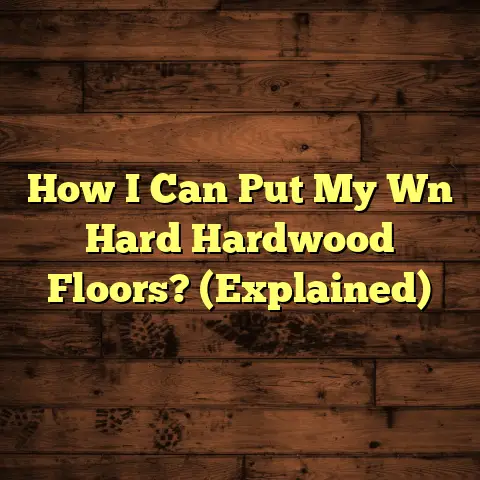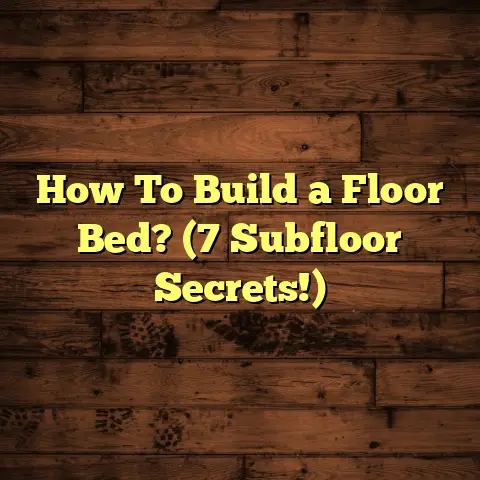Sanding Bamboo Floors: Is It Possible? (DIY Trap?)
And if there’s one thing I’ve learned, it’s that flooring can be a real head-scratcher.
Especially when it comes to bamboo.
Bamboo flooring has exploded in popularity.
And for good reason!
It’s sustainable, looks fantastic, and seems pretty darn durable.
But here’s the million-dollar question: Can you sand it?
I’ve seen so many homeowners jump into a DIY project, thinking they can tackle sanding their bamboo floors.
And trust me, I get the appeal.
Saving money and the satisfaction of doing it yourself?
Sounds great, right?
But before you grab that sander, let’s pump the brakes.
There are tons of misconceptions floating around.
And the reality is, sanding bamboo floors can be a tricky business.
Especially if you’re not a pro.
And the regional conditions?
Oh, they matter a lot.
Climate, humidity, local flooring trends…
They all play a role in whether sanding is even a good idea.
So, in this article, I’m going to break it all down for you.
We’ll explore whether sanding bamboo floors is actually feasible.
I’ll share the potential risks involved.
And we’ll discuss the implications of taking the DIY route.
My goal is to equip you with the knowledge you need.
So you can make an informed decision about your floors.
Sound good? Let’s dive in!
Understanding Bamboo Flooring
Okay, let’s start with the basics: What is bamboo flooring?
Well, it’s not actually wood.
Bamboo is a grass that’s incredibly fast-growing.
And it’s processed into flooring planks.
There are two main types you’ll typically find: solid and engineered.
Solid bamboo is made from strips of bamboo that are glued together.
Think of it like a butcher block countertop, but for your floor.
Engineered bamboo, on the other hand, has a bamboo veneer.
It’s on top of a core of plywood or other composite material.
The manufacturing process involves cutting the bamboo stalks.
Then, they shred them, treat them, and press them together.
This creates planks that are durable and stable.
But what makes bamboo so unique?
A few things!
First, it’s known for its hardness.
Strand-woven bamboo, in particular, is super tough.
Often harder than many hardwood species!
It’s also surprisingly flexible, which can help it withstand some wear and tear.
And, of course, there’s the environmental aspect.
Bamboo is a rapidly renewable resource.
Making it a more sustainable choice than traditional hardwood.
What are the main benefits of bamboo flooring?
Well, it’s got a lot going for it.
- It looks beautiful, with a clean, modern aesthetic.
- It’s relatively easy to maintain with regular sweeping and mopping.
- And, as we’ve touched on, it’s an eco-friendly option.
But here’s where things get interesting:
Regional climates can really impact how bamboo flooring performs.
In areas with high humidity, bamboo can absorb moisture.
This can cause it to expand and warp.
In drier climates, it can shrink and crack.
I’ve seen it happen firsthand.
For example, in coastal Florida, I always recommend.
Homeowners invest in a high-quality moisture barrier underlayment.
And ensure their home is properly ventilated.
Meanwhile, in the arid climate of Arizona, I advise clients to use humidifiers.
This will help maintain a stable moisture level in their homes.
And prevent the bamboo from drying out.
The Sanding Process
Alright, let’s talk about sanding.
What does it even mean to sand a floor?
Basically, sanding involves using abrasive materials.
Like sandpaper, to remove the top layers of a floor’s surface.
Why would you want to do that?
Well, there are a few common reasons:
- To remove scratches and scuffs.
- To get rid of deep wear and tear.
- To prepare the floor for refinishing.
Refinishing is when you apply a new coat of sealant.
This restores the floor’s original luster.
And protects it from future damage.
There are several types of sanding tools.
Each with its own strengths and weaknesses.
Drum sanders are powerful machines that can quickly remove a lot of material.
They’re often used for large areas and heavy-duty sanding.
Orbital sanders are gentler and less likely to cause damage.
They’re great for smoothing out surfaces and removing light scratches.
Hand sanding is exactly what it sounds like.
It uses sandpaper and elbow grease to get into corners and tight spots.
What are the general steps involved in sanding a floor?
Here’s a simplified overview:
- Preparation: Clear the room, remove furniture, and clean the floor thoroughly.
- Sanding: Use a series of progressively finer grits of sandpaper to remove the old finish and imperfections.
- Finishing: Apply a new stain or sealant to protect the floor and enhance its appearance.
Now, how does this apply to bamboo flooring?
Well, the basic principles are the same.
But there are some key differences.
Compared to traditional hardwood.
Bamboo is often more prone to splintering.
This is due to its unique fiber structure.
And the finish on bamboo floors can be more delicate.
This requires a more careful approach to sanding.
I’ve seen homeowners try to rush the sanding process on bamboo.
And end up with a floor that looks worse than before.
Trust me, patience and precision are key.
Can You Sand Bamboo Floors?
This is the big question, isn’t it?
Can you actually sand bamboo floors?
The short answer is: it depends.
It depends on the type of bamboo flooring you have.
And its overall condition.
Solid bamboo flooring can usually be sanded.
Just like traditional hardwood.
Because it’s made of solid material all the way through.
You can sand down a significant amount of the surface.
Without exposing the underlying materials.
Engineered bamboo flooring is a different story.
Remember, it has a thin veneer of bamboo on top of a core.
The thickness of this wear layer determines.
Whether or not you can safely sand it.
If the wear layer is very thin (less than 2mm).
Sanding it could expose the core material.
This would ruin the look of the floor.
And potentially compromise its structural integrity.
So, how do you know if your engineered bamboo floor can be sanded?
The best way is to check with the manufacturer.
Or consult with a flooring professional.
They can assess the thickness of the wear layer.
And advise you on whether sanding is a viable option.
What are the potential risks and challenges of sanding bamboo flooring?
Quite a few, actually:
- Splintering: Bamboo fibers can easily splinter. This can create an uneven surface.
- Damage to the finish: Over-sanding can remove the finish unevenly. This can leave unsightly patches.
- Exposing the underlying materials: Sanding engineered bamboo too aggressively. This can reveal the core, which looks terrible.
I remember one time a homeowner called me in a panic.
He had tried to sand his engineered bamboo floor himself.
And he sanded right through the veneer in several spots.
The core material was exposed.
And the floor looked like a patchwork quilt of different colors and textures.
He ended up having to replace the entire floor.
Which cost him a lot more than if he had hired a professional in the first place.
The DIY Trap
Let’s be real: DIY culture is huge right now.
Home improvement shows, YouTube tutorials…
They make it seem like anyone can tackle any project.
And I’m all for empowering homeowners to take on challenges.
But when it comes to flooring.
There’s a fine line between confidence and overconfidence.
The allure of DIY sanding is understandable.
You can save money on labor costs.
There’s a sense of accomplishment in doing it yourself.
But here’s the thing: sanding floors is not as easy as it looks.
It requires specialized equipment, technical skills, and a lot of patience.
One of the biggest pitfalls I see is.
A lack of understanding of proper sanding techniques.
Many DIY enthusiasts don’t realize.
That you need to use different grits of sandpaper in a specific sequence.
They might start with too coarse a grit.
This can gouge the floor.
Or they might not sand evenly.
This can leave swirl marks or uneven patches.
Another common mistake is using the wrong equipment.
Renting a drum sander from a big box store.
Doesn’t automatically make you a flooring expert.
Drum sanders are powerful machines.
And they can quickly remove a lot of material.
If you’re not careful, you can easily damage the floor.
I’ve seen homeowners try to use handheld sanders.
Thinking they can save money and have more control.
But handheld sanders are not designed for large areas.
And they can leave an uneven, unprofessional finish.
Insufficient preparation is another major factor.
That can lead to disastrous outcomes.
Before you even think about sanding.
You need to thoroughly clean the floor.
Remove any nails or staples, and repair any damage.
Failing to do so can result in scratches, gouges, and other imperfections.
Alternatives to Sanding Bamboo Floors
Okay, so sanding might not always be the best option.
What else can you do to maintain and restore your bamboo floors?
Luckily, there are several alternatives to sanding.
That can help you keep your floors looking their best.
One of the simplest and most effective methods is regular cleaning.
Sweep or vacuum your bamboo floors regularly.
To remove dirt, dust, and debris.
These can scratch the surface over time.
You can also use a damp mop with a mild cleaning solution.
But be careful not to use too much water.
As this can damage the bamboo.
Buffing is another great way to rejuvenate your bamboo floors.
Buffing involves using a specialized machine to polish the surface.
This can help remove light scratches and scuffs.
And restore the floor’s shine.
You can also apply a new coat of finish to your bamboo floors.
This can help protect the surface.
And enhance its appearance.
There are many products designed specifically for bamboo flooring.
These can help you rejuvenate the surface.
Without the need for sanding.
These products often contain waxes or oils.
That penetrate the bamboo and restore its natural luster.
Finally, don’t underestimate the value of professional services.
There are companies that specialize in bamboo floor maintenance.
They have the expertise, equipment, and experience.
To properly care for your floors.
Hiring a professional can be more expensive than DIY.
But it can save you a lot of headaches in the long run.
And ensure that your floors are properly maintained.
I always tell my clients that regular maintenance.
Is the key to keeping their bamboo floors looking great for years to come.
A little bit of preventative care can go a long way.
Regional Considerations
Let’s zoom out for a moment and think about regional factors.
How do they influence the decision to sand.
Or not sand bamboo floors?
As I mentioned earlier, climate conditions play a big role.
In humid regions, bamboo floors are more prone to moisture damage.
Sanding a floor that has been exposed to excessive moisture.
Can be risky, as it may be more likely to splinter or warp.
In these areas, it’s often better to focus on preventative measures.
Such as using a dehumidifier and applying a moisture-resistant finish.
In drier regions, bamboo floors are more likely to dry out and crack.
Sanding a floor that is already dry and brittle.
Can exacerbate the problem.
In these cases, it’s important to use a humidifier.
And apply a finish that will help retain moisture.
Local building practices can also influence the decision to sand.
In some areas, bamboo flooring is more common than others.
Which means there may be more professionals with experience.
In bamboo floor maintenance.
In other areas, bamboo flooring may be less common.
Which means it may be harder to find qualified professionals.
The availability of professionals is another important consideration.
If you live in an area with few bamboo flooring experts.
You may be tempted to try sanding it yourself.
But as we’ve discussed, this can be risky.
If you’re not confident in your abilities.
It’s always best to consult with a professional.
Even if it means traveling to another city or state.
I’ve seen some interesting case studies over the years.
For example, in Hawaii, where humidity is consistently high.
Many homeowners opt for engineered bamboo flooring with a thick wear layer.
This allows them to sand the floor if necessary.
But they also take extra precautions to prevent moisture damage.
Such as using a vapor barrier and maintaining proper ventilation.
In Colorado, where the climate is dry and sunny.
Homeowners often choose solid bamboo flooring.
They apply a UV-resistant finish to prevent fading and cracking.
They also use humidifiers to maintain a stable moisture level.
Conclusion
So, can you sand bamboo floors?
As we’ve seen, it’s not a simple yes or no answer.
It depends on the type of flooring you have.
The thickness of the wear layer, and the overall condition of the floor.
It also depends on your skills, your tools, and your patience.
The potential risks involved in a DIY approach are significant.
You could end up damaging the floor, exposing the core material.
Or creating an uneven, unprofessional finish.
There are alternatives to sanding that can help you.
Maintain and restore your bamboo floors.
Such as cleaning, buffing, and applying new finishes.
Regional considerations also play a role.
Climate conditions, local building practices.
And the availability of professionals can all influence your decision.
Ultimately, the best way to care for your bamboo floors.
Is to understand both their benefits and their limitations.
Bamboo flooring is a beautiful, sustainable, and durable option.
But it requires proper maintenance and care.
Before you make any decisions about sanding.
I encourage you to do your research, consult with a professional.
And consider your specific needs and regional considerations.
With the right knowledge and approach.
You can keep your bamboo floors looking their best for years to come.
And avoid the DIY trap that has ensnared so many homeowners.
Thanks for reading!
I hope this article has been helpful.
If you have any questions, feel free to leave a comment below.
And remember, when it comes to flooring.
It’s always better to be safe than sorry!





